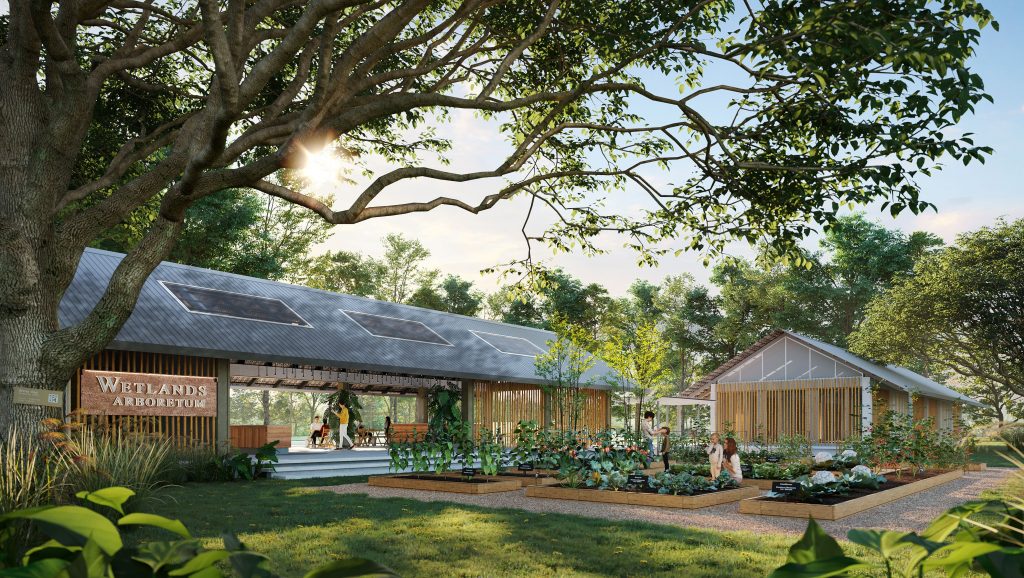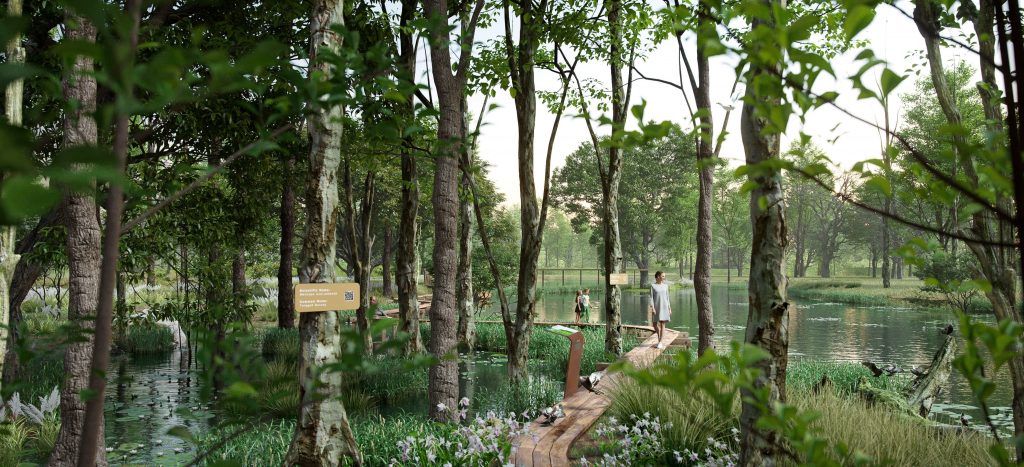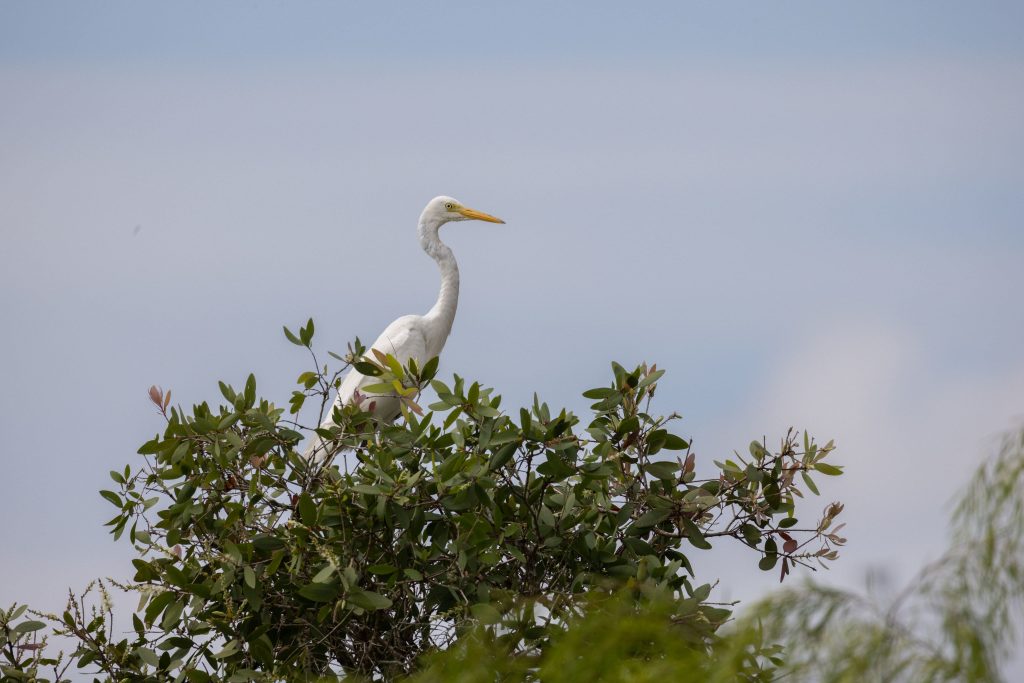Going beyond just preserving the wetlands

An artist depiction of the Wetlands Arboretum Centre, a multi-function centre in Wetlands Arboretum, Gamuda Cove.
Creating an arboretum within a wetland, within a township
Wetlands are touted for their richness in biodiversity with thousands of numerous different species that live in them. More than just providing a home to thousands of animal and plant species, wetlands provide a crucial role in food security, carbon storage, water filtration, and shoreline erosion control.
Acting as transition zones between uplands and deeper water, their unique ecosystems are characterised by their hydrology, soils and vegetation. This allows wetlands to function like natural tubs, storing surface water runoffs.
Realising this importance, especially in recent years when flash floods are becoming imminent, the 90 acres of reserved land in Gamuda Cove, adjacent to Paya Indah Discovery Wetlands, is currently being converted into a Wetlands Arboretum, a living tree museum.
Wetland arboretums, also known as wetland gardens or water gardens, are natural ecological gardens that are designed to showcase wetland environments. These gardens are becoming increasingly popular around the world as more people become aware of the importance of preserving wetlands and the wildlife that inhabits them.
As a wetland sanctuary, it also combats global warming through the sequestration of environmental carbon and carbon-rich organic sediments.

Proper walkways will allow visitors to have a closer appreciation of the wetlands
Listening to the land
As a consultant on the project, landscape architectural firm SD2 Sdn Bhd director Lee Wern Ching was initially quite surprised when Gamuda Land through Gamuda Parks approached the firm to look into the design and restoration of the greenery in the area as the land has been disturbed over the past few decades before Gamuda Land acquired the land a few years back.
It was a monumental task to first come up with such capital expenditure. Not only to restore nature but also to ensure that the community can spend time in this place to appreciate nature, more so on a buffer zone where most developers would opt to just do the bare minimum.
He commended Gamuda Land for putting in the effort to restore the land by establishing an arboretum for wetlands, stating: “To bring this idea to life and with the neighbouring Paya Indah Discovery Wetlands, it made sense to extend the wetlands into this buffer zone.”
Lee and his team of experts designed and provided expert advice on the Wetlands Arboretum as well as on the Wetlands Arboretum Centre, a welcome pavilion for visitors and a multi-function central hub for various activities.
He continued: “The beauty of the Wetlands Arboretum is that it is not focused on just the Centre but the whole Wetlands Arboretum, which is open to the public.”
He pointed out that rather than a closed-up area where people do not interact with the environment, visitors get to feel and experience what the arboretum has to offer.
Lee explained that while the arboretum is a built environment, many areas are opened up to allow visitors to view the wetlands without damaging them as proper walkways and paths are built to keep the existing wetlands intact.
“Remember, the arboretum is not an entertainment park. It is to improve the people’s understanding of biodiversity and build a deeper appreciation of the importance of wetlands,” he added.
As the 90-acre Wetlands Arboretum is easily accessible, residents are able to connect with nature in the Wetlands Arboretum with activities such as jogging, jungle trekking and bird-watching.
In addition, its water features and natural setting enhance the well-being of surrounding communities, while promoting healthy interaction between them and the natural environment.
Meanwhile, the Wetlands Arboretum will catalyse economic growth in the area by creating eco-tourism opportunities and green jobs such as arborists, horticulturalists, botanists and more.

Actual photo of the Intermediate Egret found at Gamuda Cove. The Intermediate Egret are among the many bird species attracted to the fruits of the Melicope-Lunu Anakenda tree.
Careful curation of Wetlands Arboretum
“Unlike parks and recreation areas, the arboretum has an educational aspect to it. One of the main attractions of the Wetlands Arboretum is the wide variety of plant life on display. It is a collection of trees and vegetation, some of which are very rare,” Lee said.
The Wetlands Arboretum will be home to more than 300 species of flora and fauna. In collaboration with Forest Research Institute Malaysia (FRIM), the species were carefully selected, introducing 100% native species and at least 1,000 trees with conservation importance, as classified by the International Union for Conservation of Nature (IUCN).
Another partner to the Wetlands Arboretum, specifically on the Wetlands Arboretum Centre, is Universiti Malaya (UM) Faculty of Science’s Institute of Biological Sciences senior lecturer Dr Nurul Ashikin Abdullah.
According to Dr Nurul, “The Wetlands Arboretum Centre will display specimens of plants that are specialised for peat swamp habitats. The community can benefit from the knowledge on the importance of each species (such as the usage, medicinal values and more), especially since these species are native to Malaysia. Understanding the ecological role and values of such plants will create awareness among the general public which in turn can help protect our natural resources.”
Selecting the right species of trees to be planted in peat-soil conditions proved to be one of the main challenges when designing the Wetlands Arboretum. Not only are there limited trees that can withstand long stays in water, but such species are also at risk of being endangered, hence are difficult to source.
One such example is Melicope Lunu-Ankenda or known locally as Tenggek Burung. It is an evergreen shrub which best fits the profile to be planted in the arboretum but was not an easy find. After a successful attempt at sourcing for the endemic seed, the team propagated and nurtured the tree specimens until it is matured enough to be transplanted.
This led to an indigenous nursery in Pulau Kempas which has produced approximately 10,000 Melicope Lunu-Ankenda saplings to date for tree planting activities within the Wetlands Arboretum.
The project is envisioned to serve as a basecamp for seed and tree storage as well as recycling of organic, garden and general waste while offering on-ground research and collaboration opportunities for conservationists and others keen to study and explore its natural treasures.
Drawing insights from various scientific research of arborists, the Wetlands Arboretum will be a national biodiversity asset that aims to encourage collaborative efforts among environmentalists and the general public with the aim of fighting climate change and fostering education and biodiversity research.
The Wetlands Arboretum will be opened in phases with the first phase targeted for opening by the third quarter of 2023.

The arboretum has an educational aspect to it, said Lee.

Nurul said the community can benefit from the knowledge gained.
Stay ahead of the crowd and enjoy fresh insights on real estate, property development, and lifestyle trends when you subscribe to our newsletter and follow us on social media.
